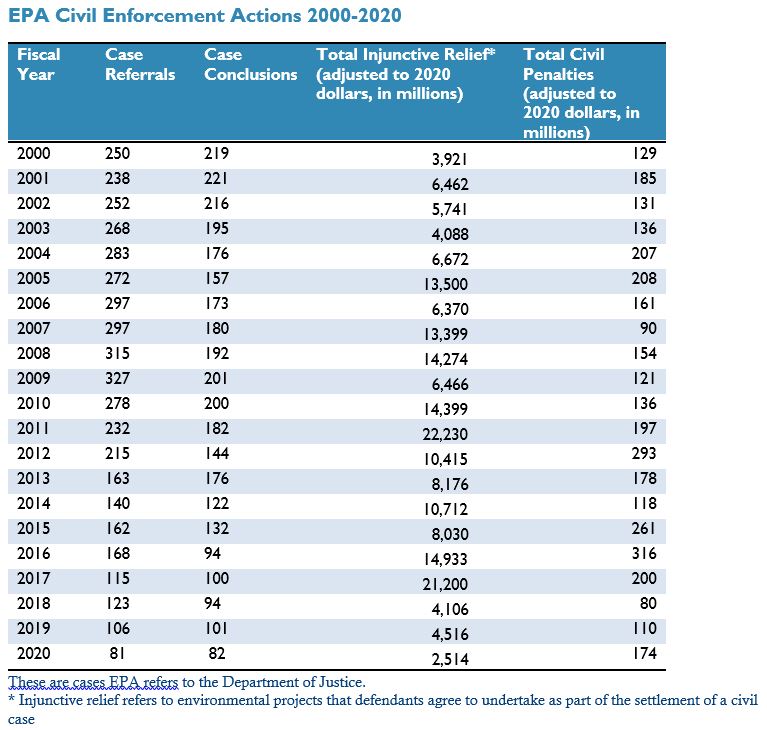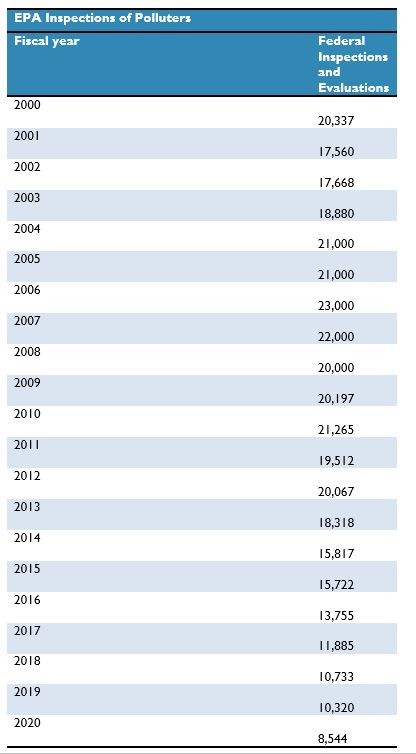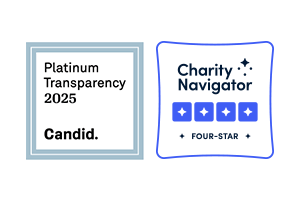COVID-19 Likely Affected Environmental Enforcement in 2020, But Long-term Decline Needs to Be Reversed by Biden Administration
Washington, D.C. – Environmental Protection Agency enforcement data released yesterday show a continuation of a long-term decline in many areas of environmental enforcement in 2020, with some record lows reached under the Trump Administration.
An Environmental Integrity Project compilation of two decades of EPA data shows that, in the federal fiscal year that ended on Sept. 30, 2020, the Trump Administration EPA had the lowest number of civil judicial environmental cases concluded (82), the lowest number of civil judicial cases referred for prosecution (81), the lowest number of inspections (8,544), and the fourth lowest Superfund cleanup and cost recovery totals ($815 million) in the last 20 years, with figures adjusted for inflation.
“EPA’s enforcement program deserves credit for what it was able to accomplish during the COVID-19 pandemic, and particularly for its efforts to keep fraudulent disinfectants and ‘anti-viral’ products out of the marketplace,” said Eric Schaeffer, Executive Director of the Environmental Integrity Project and former Director of Civil Enforcement at EPA. “But the results released today and over the past four years confirm the long-term decline in federal enforcement of environmental law, whether compared to the record under the Obama Administration or over the past two decades.”
Schaeffer continued: “These declines in environmental enforcement can be found in the number of cases brought against violators; the number of inspections to check on whether industries are complying with federal environmental laws; the penalties that polluters are required to pay for breaking those laws; and the amounts that responsible parties are required to spend to clean up abandoned dumpsites under Superfund, or to install pollution control equipment needed to stop illegal emissions of air or water pollution.”
Some long-term trends revealed in the EPA data released yesterday, after adjusting for inflation to 2020 dollars:
- Despite boasts from the Trump EPA about its allegedly increased efforts to clean up Superfund sites, federal data show a sharp drop-off in Superfund cleanup investments during the Trump Administration, as compared to the Obama and George W. Bush years. EPA data show an average of $999 million annually spent on Superfund cleanup projects during federal fiscal years 2017-2020. This was about half the $2 billion per year from 2009-2016 (during Obama’s term); and about 33 percent less than the $1.5 billion per year average from 2001 to 2008, during George W. Bush’s two terms. (Note that the results for fiscal years 2017, 2009, and 2001 straddle incoming and outgoing Administrations).
- Civil penalties against polluters were significantly lower under Trump than Obama, but slightly better than under George W. Bush. Federal numbers show an average of $603 million per year in civil penalties recovered from polluters from 2017-2020, compared to $1 billion annually from 2009-2016 (during Obama’s term) and $159 million annually during George W. Bush’s two terms.
- The new EPA data also show the lowest annual amount spent by polluters on “injunctive relief” In civil cases. That is money that enforcement agreements require polluters to spend on pollution controls or cleanup projects under the federal Clean Air Act, Clean Water Act, and other non-Superfund cases. The amount spent in fiscal 2020 ($2.5 billion) is about a quarter of the 20-year average of $9.9 billion. Injunctive relief averaged $8 billion between the 2017 and 2020 fiscal years, but that includes a $4.7 billion consent decree with Volkswagen approved on October 26, 2016, while the Obama Administration was still in office (the 2017 federal fiscal year began on October 1, 2016).
- EPA’s inspections of polluters fell to a record low under the Trump Administration. EPA conducted an average of 10,371 inspections per year from fiscal years 2017 through 2020, compared to 18,082 annually from 2009-2016, and 20,139 annually from 2001 to 2008.
- Criminal cases against polluters have been declining for two decades, but then plummeted by more than half under Trump compared to Obama. Federal data show that EPA opened an average of 165 criminal cases per year between fiscal years 2017-2020, compared to 297 annually from 2009-2016, and 400 annually from 2001 to 2008. However, EPA did open 274 new criminal cases in 2020, a significant increase compared to the prior year.
- Civil cases against polluters have also been falling for years, but hit a low under Trump. EPA referred an average of 106 civil cases to the Justice Department for prosecutions from fiscal years 2017-2019, compared to 211 per year from 2009-2016 and 278 per year from 2001 to 2008.
Below is a chart comparing EPA enforcement numbers for four most recent fiscal years to the 20-year average, and periods under prior administrations:
| FY 2020 Reported Value | FY 2017-2020 Average (Trump) | FY 2009-2016 Average (Obama) | FY 2001-2008 Average (Bush) | 20-year Average | |
| Civil Case Conclusions | 82 | 94 | 156 | 189 | 157 |
| Civil Case Referrals | 81 | 106 | 211 | 278 | 217 |
| Injunctive Relief (non-Superfund) | $2,514 | $8,084 | $11,920 | $8,813 | $9,910 |
| Civil Penalties | $174 | $603 | $1,092 | $159 | $621 |
| Civil Penalties (excluding individual cases recovering more than $300 million in penalties). | $174 | $141 | $202 | $159 | $173 |
| Criminal Polluters Charged | 91 | 118 | 226 | 282 | 227 |
| Criminal Cases Opened | 247 | 165 | 297 | 400 | 312 |
| Criminal Fines and Restitutions | $42 | $853 | $312 | $93 | $333 |
| Criminal Fines and Restitutions Penalties (excluding individual cases recovering more than $1 billion in penalties). | $42 | $139 | $146 | $93 | $124 |
| Inspections | 8,544 | 10,371 | 18,082 | 20,139 | 17,362 |
| Total Superfund Money | $815 | $999 | $2,045 | $1,485 | $1,612 |
All penalty or cost estimate dollar figures in the table above are reported in millions of 2020 dollars. The above chart includes total civil and criminal penalties paid, and an alternative comparison that removes large “outlier” cases, such as the $1 billion civil penalty for the BP Horizon Oil Spill in FY 2013 and the $3.4 billion recovered from Duke Energy in 2015.
For a copy of EIP’s spreadsheet with 20 years of EPA enforcement data, click here.
The Environmental Integrity Project is a 19-year-old nonprofit organization, based in Washington D.C. and Austin, Texas, that is dedicated to enforcing environmental laws and strengthening policy to protect public health and the environment.


###
Media contact: Tom Pelton, Environmental Integrity Project (443) 510-2574


